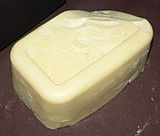- Cocoa butter
-
Cocoa butter
Raw cocoa butter
Fat compositionSaturated fats 57-64%: stearic acid (24-37%), capric acid (0-10%), myristic acid, (0-4%), arachidic acid (1%), lauric acid (0-1%) Unsaturated fats 36-43% Monounsaturated fats 29-43% (29-38% oleic acid, 35–41% palmitoleic acid), 0-2% Polyunsaturated fats 0-5% (linoleic acid, 0–3%, 1-4%, Linolenic acid (0-1%)
PropertiesFood energy per 100g 3770 kJ (900 kcal) Melting point 34.1 °C (93.4 °F), 35–36.5 °C (95–98 °F) Solidity at 20 °C solid Refractive index 1.44556-1.44573 Iodine value 32.11-35.12, 35.575 Acid value 1.68 Saponification value 191.214, 192.88-196.29 Cocoa butter, also called theobroma oil or theobroma cacao, is a pale-yellow, pure edible vegetable fat extracted from the cocoa bean. It is used to make chocolate, biscuits, baked goods as well as some pharmaceuticals, ointments, and toiletries.[1] Cocoa butter has a mild chocolate flavor and aroma.
Contents
Composition and extraction
Cocoa butter has a high content of saturated fats derived from stearic and palmitic acids.[2][3] Cocoa butter, unlike cocoa solids, has no more than trace amounts of caffeine and theobromine.[4]
 The main constituent of cocoa butter is the triglyceride (fat) derived from palmitic acid, stearic acid, and oleic acids.
The main constituent of cocoa butter is the triglyceride (fat) derived from palmitic acid, stearic acid, and oleic acids.
Cocoa butter is obtained from either whole cacao beans, which are fermented, roasted, and then separated from their hulls. About 54 – 58% of the residue is cocoa butter. Chocolate liquor is pressed to separate the cocoa butter from the cocoa solids.[5] The Broma process is used to extract cocoa butter from ground cacao beans. Cocoa butter is usually deodorized to remove its strong and undesirable taste.[6]
Adulterants
Some food manufacturers substitute less expensive materials such as vegetable oils and fats in place of cocoa butter. (See false advertising). Several analytical methods exist for testing for diluted cocoa butter. Adulterated cocoa butter is indicated by its lighter colour and its diminished fluorescence upon ultraviolet illumination. Unlike cocoa butter, adulterated fat tends to smear and have a higher non saponifiable content.[7]
Uses
Cocoa butter is the major ingredient in the commercial production of both white chocolate and milk chocolate. This application continues to dominate consumption of cocoa butter.
Pharmaceutical companies exploit cocoa butter's physical properties. As a nontoxic solid at room temperature that melts at body temperature, it is considered an ideal base for medicinal suppositories.
Niche uses
Cocoa butter is one of the most stable fats known, a quality that coupled with natural antioxidants that prevent rancidity, grants it a storage life of two to five years. The velvety texture, pleasant fragrance and emollient properties of cocoa butter have made it a popular ingredient in products for the skin, such as cosmetics, soaps and lotions.
The moisturizing abilities of cocoa butter are frequently recommended for prevention of stretch marks in pregnant women, treatment of chapped skin and lips, and as a daily moisturizer to prevent dry, itchy skin. However, the largest clinical study regarding the effects of cocoa butter on stretch marks in pregnant women found that results were no different from placebo.[8]
Physical properties
The most common form of cocoa butter has a melting point of around 34-38 °C (93-100 °F), rendering chocolate a solid at room temperature that readily melts once inside the mouth. Cocoa butter displays polymorphism, having α, γ, β', and β crystals, with melting points of 17, 23, 26, and 35–37 °C respectively. The production of chocolate typically uses only the β crystal for its high melting point. A uniform crystal structure will result in smooth texture, sheen, and snap. Overheating cocoa butter converts the structure to a less stable form that melts below room temperature. Given time, it will naturally return to the most stable β crystal form. This phenomenon is taken advantage of in the polymorphic transformation theory of chocolate bloom. It is based on the fact that bloomed chocolates are always found to contain the most stable polymorph of cocoa butter. According to this theory, bloom occurs through the uncontrolled polymorphic transformation of cocoa butter from a less stable form to the most stable form.
References
- ^ "Cocoa butter – Britannica Online Encyclopedia". Britannica Encyclopedia article. July 1998. http://www.britannica.com/eb/article-9024603/cocoa-butter. Retrieved 2007-09-10.
- ^ Liendo, Rigel; Fanny C. Padilla and Agricia Quintana (November 1997). "Characterization of cocoa butter extracted from Criollo cultivars of Theobroma cacao L.". Food Research International 30 (9): 727–731. doi:10.1016/S0963-9969(98)00025-8.
- ^ El-Saied, Hani M.; M. K. Morsi, and M. M. A. Amer (June 1981). "Composition of cocoa shell fat as related to cocoa butter". Zeitschrift für Ernährungswissenschaft 20 (2): 145–151. doi:10.1007/BF02021260.
- ^ USDA nutrient database
- ^ Cocoa butter pressing
- ^ The Nibble. "The World’s Best White Chocolate Page 3: Percent Cacao & Cocoa Butter". http://www.thenibble.com/zine/archives/best-white-chocolate3.asp#fillings. Retrieved 2009-03-03.
- ^ Alfred Thomas (2002). "Ullmann's Encyclopedia of Industrial Chemistry". Ullmann's Encyclopedia of Industrial Chemistry. Weinheim: Wiley-VCH. doi:10.1002/14356007.a10_173. ISBN 3527306730.
- ^ O'Connor, Anahad (2009-09-15). "The Claim: Cocoa Butter Can Remove Stretch Marks". The New York Times. http://www.nytimes.com/2009/09/15/health/15real.html. Retrieved 2010-04-30.
Edible fats and oils Fats Oils Almond oil · Argan oil · Avocado oil · Canola oil · Cashew oil · Castor oil · Coconut oil · Colza oil · Corn oil · Cottonseed oil · Fish oil · Grape seed oil · Hazelnut oil · Hemp oil · Linseed oil (flaxseed oil) · Macadamia oil · Marula oil · Mongongo nut oil · Mustard oil · Olive oil · Palm oil (palm kernel oil) · Peanut oil · Pecan oil · Perilla oil · Pine nut oil · Pistachio oil · Poppyseed oil · Pumpkin seed oil · Rapeseed oil · Rice bran oil · Safflower oil · Sesame oil · Soybean oil · Sunflower oil · Tea seed oil · Walnut oil · Watermelon seed oilSee also: List of vegetable oils · Cooking oil · Essential oil Chocolate Background Outline of chocolate · History of chocolate · Health effects of chocolate · History of chocolate in Spain
Origins Varieties Chemicals See also Categories:- Vegetable fats
Wikimedia Foundation. 2010.

